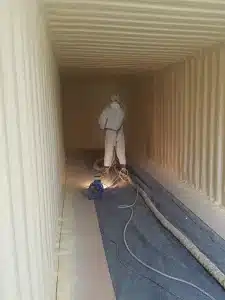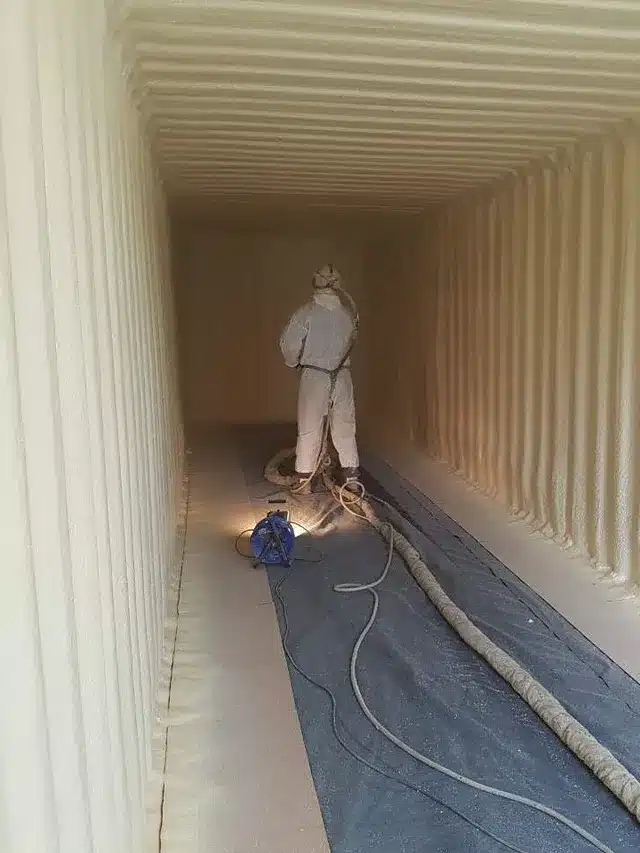Designed for our Canadian weather!

Certainly! Here’s an expanded version of that point:
—
One of the most frequently asked questions we encounter is about the insulation of container houses. We completely understand how crucial proper insulation is for comfort, energy efficiency, and durability. That’s why we ensure that every container home we build comes with a minimum of 6 inches of high-quality foam insulation. This thickness typically provides an impressive R-value ranging between R27 and R39, depending on the specific materials and construction methods used. Such insulation levels help maintain a consistent indoor temperature, keeping your home warm during the winter and cool throughout the summer, while also reducing energy consumption and lowering utility bills.
Additionally, our foam insulation is carefully applied to prevent thermal bridging and air leaks, which are common challenges in metal container structures. This ensures that the container house performs as well as, or better than, traditional home constructions in terms of insulation. For those interested in even greater energy efficiency, we offer customizable options to increase the insulation thickness or integrate advanced insulating materials.
If you’d like to explore the benefits of insulated container homes further, including detailed technical specifications, installation processes, and energy savings estimates, we invite you to visit our website. There, you’ll find comprehensive information, customer testimonials, and examples of completed projects that demonstrate how our insulation solutions contribute to creating comfortable, sustainable living spaces inside container houses.
—
Enhanced Insulation for Your Container Home
Are you looking for a comfortable and energy-efficient home? Insulation is a key factor, and we understand its importance. All our container homes feature a minimum of 6 inches of high-quality foam insulation, providing an R-value between R27 and R39. This ensures consistent temperatures year-round, reduces energy costs, and enhances the durability of your home.
Our insulation is carefully installed to prevent thermal bridging and air leaks, matching or exceeding the insulation performance of traditional homes. Explore customizable options for even greater energy efficiency.
Visit our website to explore a comprehensive range of information about the numerous benefits of insulated container homes. We provide in-depth technical details that explain how advanced insulation materials work to regulate indoor temperatures, reduce energy consumption, and enhance structural durability. Learn about our efficient installation processes, designed to be quick, cost-effective, and environmentally friendly, ensuring your container home is ready for you to enjoy as soon as possible.
Additionally, discover detailed case studies and energy savings data that demonstrate how our insulation solutions contribute to lower utility bills and reduced carbon footprints. By choosing our insulated container homes, you’re investing in comfortable, sustainable living spaces that combine modern design with eco-conscious innovation—perfect for anyone looking to create a healthier home environment while minimizing environmental impact. Visit us now to start your journey toward a greener, more efficient lifestyle.
[Button: Explore Our Container Homes]
Insulation
“Nothing beats the warmth of a home” captures a profound truth about the comfort and security that a home provides, far beyond just its physical structure. A home is more than four walls and a roof; it is a sanctuary where people find emotional refuge, a place filled with memories, love, and a sense of belonging. The warmth of a home comes from the relationships shared within it — the laughter of family and friends, the support during difficult times, and the daily rituals that create a rhythm of life.
Certainly! Here’s an expanded version of your point:
Unlike transient places or fleeting material possessions that can easily be lost, outgrown, or taken away, the warmth of a home embodies something far deeper and more enduring: consistency and unconditional acceptance. While possessions may bring momentary pleasure, and temporary locations may offer change, the true comfort of home lies in its unwavering presence as a sanctuary for the heart and mind. It nurtures the soul by creating a space where one can shed external masks and societal expectations, allowing individuals to relax fully, recharge their energy, and reconnect with their authentic selves.
In an age characterized by rapid change, constant connectivity, and pervasive uncertainty, the home acts as a grounding force. It is a haven where time slows down just enough to offer moments of calm and reflection, reminding us of the fundamental human need for connection—to ourselves, to loved ones, and to a sense of belonging. This sense of stability is crucial to maintaining our emotional equilibrium and fostering inner peace amid life’s inevitable ups and downs.
The intangible warmth experienced within a home cultivates a unique form of happiness and resilience that external luxuries, no matter how lavish, cannot replicate. Whereas material wealth can provide comfort only on a superficial level, the emotional security and unconditional acceptance found at home sustain us through challenges, inspire personal growth, and promote mental well-being. It serves as the foundation from which we draw strength, confidence, and hope, ultimately enriching our lives in ways far beyond the physical environment itself.
![]()



Comments are closed